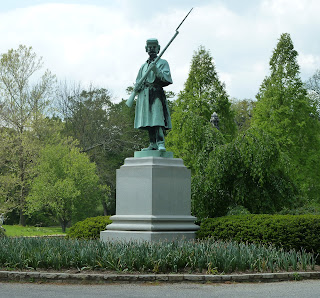| Source: Cincinnati Zoo at Wikimedia Commons |
The Cincinnati Zoo and Botanical Garden has been in operation since 1875, and is one of the oldest zoos in the United States. While I sometimes have mixed feelings about zoos and struggle with the idea of animals in captivity, I do believe the Cincinnati Zoo does a lot of amazing work. Of the zoos I have visited in the US, it is by far the best.
Every May, the Zoo puts on Zoo Babies, which is a celebration of all the baby animals born in recent months. Unsurprisingly, it is a very popular month at the Zoo, as it's hard for anyone to resist the baby animals. This year, I am in love with these baby wallabies, who are currently living in the Zoo nursery.
One of the things that impresses me the most about the Cincinnati Zoo is their Center for the Conservation and Research of Endangered Wildlife, or CREW. CREW is a state of the art research facility, and it is dedicated to saving endangered plants and animals from extinction. Their slogan is "Saving Species with Science."
In addition to working in the CREW facility here in Cincinnati, CREW scientists and researchers are dedicated to the protection of endangered animals in their native habitats. To that end, CREW has worked in Mongolia on an ecological study of wild pallas' cats and trained Mongolian students to work for the conservation of the cats' habitat, and founded an international consortium to work towards protecting the habitat of ocelots in Brazil. In addition, CREW has done groundbreaking work on saving the Sumatran rhinoceros from extinction.
| Source: Cincinnati Zoo at Wikimedia Commons |
CREW celebrated its 30th birthday in 2011, and I think their work is definitely something to celebrate here in Cincinnati. The CREW scientists are internationally recognized for their Signature Projects, which include small cats, rhinos, and endangered plants.
And with that, I am done with my A-Z of Cincinnati Challenge! Thank you to everyone who has stopped by here and read my posts, it's been great to meet new friends and catch up with some old ones along the way.
Big thanks as well to the 2012 A-Z Challenge hosts:
Tossing It Out (Arlee Bird) Amlokiblogs (Damyanti Biswas) Alex J. Cavanaugh (Alex J. Cavanaugh) Life is Good (Tina Downey) Cruising Altitude 2.0 (DL Hammons) Retro-Zombie (Jeremy Hawkins) The Warrior Muse (Shannon Lawrence) The QQQE (Matthew MacNish) Author Elizabeth Mueller (Elizabeth Mueller) Pearson Report (Jenny Pearson) No Thought 2 Small (Konstanz Silverbow) Breakthrough Blogs (Stephen Tremp) Coming Down The Mountain (Karen Jones Gowen)
Kudos to all of my fellow A-Z participants. It's been a great month! :)













































